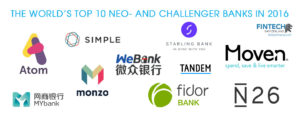“Challenger Banks” are financial services and technology startups that are offering (mostly) retail banking services to consumers, attempting to replace the more traditional incumbent banks that most “banked” people use today. They attempt to capitalize on general discontent with banks (bad customer service, high fees, shady business practices, no lending, horrendous business processes), and on the information technology advantage offered through the advent of ubiquitous mobile devices, cheap cloud computing, and software development improvements that allow 10-developers teams to compete on features with 10,000 developers at large banks.
How To Make Money?
There are two ways of being a challenger bank – either by getting a banking license (a “charter”) or by buying banking services wholesale from existing banks inclined to do that. The first path has been followed mostly by startups in the UK, and the second by everyone else facing the hurdle of financial services regulations that seem designed to ensure status quo.
The best-known definition of a startup comes from Steve Blank: “a startup is an organization formed to search for a repeatable and scalable business model”, and in that sense a challenger bank is not a startup, as none of them so far has found new ways to make money (a.k.a. “business model”). Banks have two major sources of revenue, fees and NII (net interest income, the difference between interest paid on deposits and interest charged on loans) leveraged through “fractional-reserve banking” (Fractional-reserve banking is the practice whereby a bank accepts deposits, makes loans or investments, and holds reserves equal to a fraction of its deposit liabilities). Note that I am not talking about “challenger banks” that make money as software vendors, that will be another blog post.
Even with a banking charter, it is quasi-impossible for a venture-backed startup to have enough capital to create a business unit to generate revenue from NII – let alone having a robust credit underwriting process and system to ensure profitability. Very easy to give people money, much more difficult to get them to pay it back…
Fees, Fees, And More Fees
Which leaves “fees” as the only viable alternative deployed so far. Of course, most of the startups use as a marketing message “no fees”, which is a dubious claim since it implies that they run a business as a charity funded by venture capital. We have even seen “no fees” on one bank web page and a “fees schedule” on another – which is almost a positive development…
When one looks at the “no fees” claims in more detail, we see all of the challenger banks having a revenue source from a slice of the interchange fee, as they act either as an issuing bank, or as an agent for a wholesale issuing bank (in a credit card or debit card transaction, the card-issuing bank in a payment transaction deducts the interchange fee from the amount it pays the acquiring bank that handles a credit or debit card transaction for a merchant). In the end, it is still a fee, just it’s hidden from view, as customers pay it eventually in the price they get charged. There is an argument here that the merchant pays the interchange fee, however, the first money movement starts from the customer wallet/account, so my view is that customers pay the interchange fee.
So “no fees” really is “hidden fees” for customers. Outside the honesty problem, most challenger banks have a business model problem, as #1 interchange fees are under attack by regulators as customers want “free banking” without any thought for the long-term viability of such a model, and #2 the other parties in the transactions take their own share, and many time the wholesale card issuer gets the lion share as they do need to run a viable business, since they all know that “startups come and go”…, and #3 the revenue is not enough to run any sizable business that wants to become profitable sometime in the future and not be forever hooked to the VC IV.
Next?
Are there solutions to this “challenger bank” business model challenge? Maybe, many executives are starting to see the problem, some are trying to fundamentally rethink their business model, some are blissfully happy and excited and “think positive”.
The “challenger bank” day of reckoning is approaching. Maybe not tomorrow, maybe not next week, but the outcome is inevitable. Banking, as any other business, cannot be a charity.
(Some of these thoughts were presented at the Paris Fintech Forum earlier this year).
